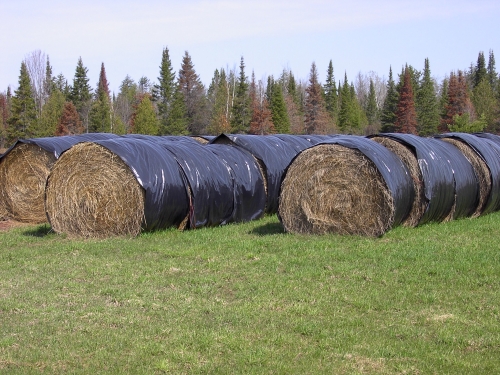Large round bale storage
By properly storing large round bales outside, dry matter and nutrient loss can be minimized
Although we had rough growing seasons this year, farmers were still able to make large round bales. Large round bales reduce labor requirement, however, storage losses of large round bales are generally much higher than small rectangular bales, particularly when stored outdoors. This indicates that a lot of large round bales might have had some nutrient loss from precipitation combined with air temperature and humidity. Much of the dry matter loss with outdoor storage is associated with microbial respiration under optimal moisture, temperature, and nutrient condition for microbes. Following are a number of ways to minimize large round bale loss stored outside:
Dense large round bale
One of the most important ways to reduce round bale loss is to tighten the outer layer of bale. If the bale is not tight enough, microbes are going to use oxygen to break down the bale using moisture and nutrients. If you can depress the surface more than a half inch, the round bale could experience significant loss when placed outside and unprotected. It’s recommended to have a density of a minimum of 10 lbs of hay per cubic ft.
Covers
Round bales stored outside and covered with either plastic or canvas (5-7% dry matter loss) generally reduce much less deterioration compared to unprotected bales (25-30% dry matter loss). Weathering can reduce forage quality of round bale hay, particularly digestibility. Plastic wrap, net wrap, reusable tarps, or plastic twine can also be used to prevent the loss from weathering.
Well-drained site
Selecting a good storage site is another important consideration in reducing bale loss with little cost involvement. The storage site should not be shaded and should be open to circulate air, which will enhance drying conditions. The storage site also should be well-drained to reduce moisture absorption into the bottom side of the round bales. A well-drained, 4-6 inch coarse rock base would help minimize bottom spoilage of a large round bale. Bale storage loss can be reduced by elevating the bales rather than being on the ground, since ground contact can account for over half of the total dry matter loss. To elevate the bales from the ground use racks, fence posts, discarded pallets, railroad ties, used tires or a layer of crushed rock about six inches deep to have good drainage.
Orientation of bale stack
It’s recommended to stack large round bales in rows, buff end-to-end, with three feet between rows, and orient in a north/south direction. This will allow the area to dry faster after a rain by having good sunlight and air flow. Vegetation between rows should be mowed to have better air flow.




 Print
Print Email
Email




